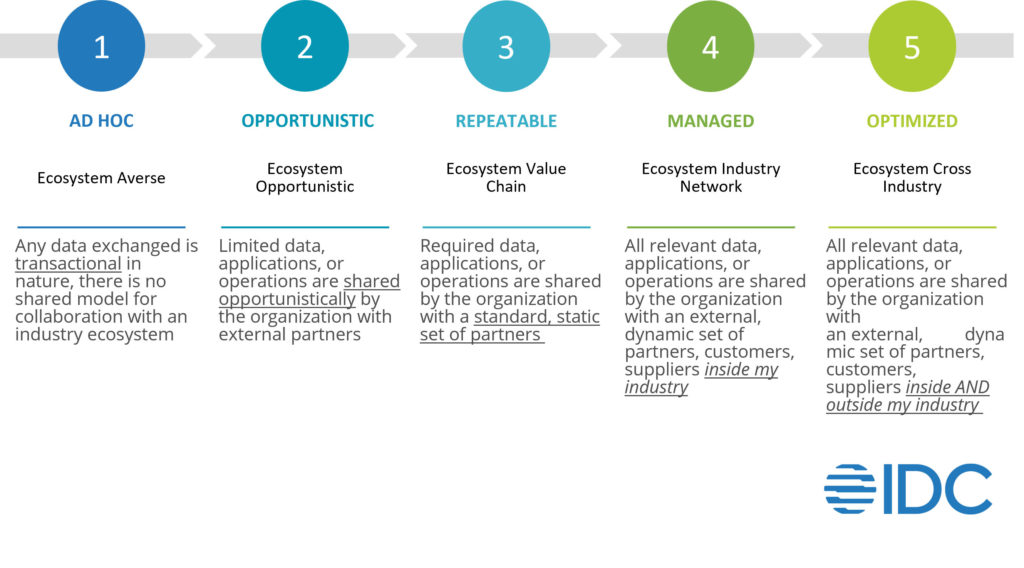Every industry ecosystem is unique, with a different core mission and set of participants. Each ecosystem will scale and change over time, depending on the customer, consumer, citizen, or patient needs and/or the natural disruptions that will occur.
In some industries, shared data & insights has emerged as the preeminent ecosystem business model, while in others, joint ventures to develop new applications addressing common problems or opportunities is the focus. Some organizations, as we saw emerge during the pandemic, realized that a shared operations and expertise approach helped to fill skills and knowledge gaps in an on-demand way.
The reality is that many organizations do not work in a shared, co-innovative way with industry ecosystem partners. They may have limited or no sharing and collaboration other than the day-to-day connection with suppliers or service providers. For some, that may be enough. We think, however, that every organization can benefit from expanding the breadth and type of industry ecosystem partners, from a variety of industries.
In fact, our 2021 global Future of Industry Ecosystems survey showed that by the end of 2023, almost 60% of respondents will be expanding the number of partners they work with outside of their core industry. This is the ultimate state of an industry ecosystem, but accessible to any size organization, even if for a specific short-term project, initiative, or use case. However, it could be that extending outside of a core industry is not feasible or desired for an organization, so the goal is to establish a diverse industry ecosystem of partners within the core industry that support and enhance every aspect of their business.
To that end, I have developed an IDC MaturityScape: Future of Industry Ecosystems as a guide for organizations planning to expand their ecosystems, wherever they are on their journey.
The first step is identifying how mature the current approach is, and then where to evolve. This evolution could span limited sharing of data, applications, and operations to sharing across a value chain, industry network, and eventually, across multiple participants from different industries. Within the report, we describe each of the phases, as well as the supporting dimensions and sub-dimensions that organizations in every industry need to consider as the next phase of digital transformation takes hold. That is, expanding innovation, decision making, and digital technology outside of the enterprise to enhance growth, improve resiliency, and consistently meet customer, consumer, citizen, or patient needs effectively.
The phases of our MaturityScape model – as depicted in the following figure – span ad hoc, opportunistic, repeatable, managed, and optimized.

Expanding industry ecosystems, sharing data, applications, and operations openly with partners, is the next step in digital transformation. Digital technology investments in cloud infrastructure and applications, business process orchestration, application development, AI, mobility, and analytics will enable better, faster communication, collaboration, data sharing, and innovation with ecosystem partners. The challenge will be determining the starting point, and aspiration, for industry ecosystem expansion.
The Future of Industry Ecosystems is upon us, with our global survey data showing that CEOs and executive leadership recognize the critical supporting role that partners play in ensuring the growth and stability of their businesses. Examples of shared data & insight, shared applications, and shared operations and expertise will continue to abound across every industry to facilitate innovation, ensure safety and quality, and engage more closely with customers, consumers, citizens, and patients so that needs are met quickly. The first steps have been taken by many organizations to expand their industry ecosystems, establishing a network of capability, capacity, support, expertise, and knowledge that can be scaled up and down as required. The next step, according to our 2022 Future of Industry Ecosystems global survey, is to incorporate partners from outside the core industry, to learn best practices and add assets, resources, and knowledge as necessary.
Detail on the dimensions and subdimensions of our Industry Ecosystems maturity model, as well as guidance to organizations across the different phases, is available in the report
IDC MaturityScape: Future of Industry Ecosystems 1.0 to subscribers of the Future of Industry Ecosystems practice.




